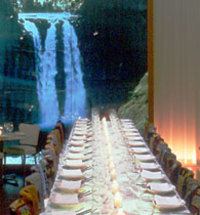Wild Salmon
 Thursday, May 10, 2007 at 09:11PM
Thursday, May 10, 2007 at 09:11PM 
Note: Wild Salmon closed at the end of 2007, yet another failure for Jeffrey Chodorow. The space became Richard Sandoval’s Zengo.
*
Wild Salmon is the latest offering from restauranteur Jeffrey Chodorow. His China Grill Management empire now spans twenty-five restaurants in ten cities—several of them mini-chains, such as Asia de Cuba and China Grill, both in five cities. The first opened in 1987, so it’s clear he turns them out in a hurry.
He’s also a prolific failure. Just three months ago, Kobe Club received zero stars from Frank Bruni of the Times. It was a replacement for another failure, Mix in New York. Wild Salmon replaces the failed English is Italian, which replaced the failed Tuscan, which replaced the failed Tuscan Steak. Across town, there was the failed Rocco’s (made famous in the TV series The Restaurant) and its successor, the failed Brasserio Caviar and Banana. All gone.

The Upstairs Bar
Wild Salmon, described as “A Pacific N. W. Brasserie,” looks to have a brighter future. A solid and moderately priced seafood restaurant, it should have no trouble drawing on an East Midtown corporate audience looking to eat well, if unadventurously.
Chef Charles Ramsayer, who moved to New York from Seattle, flies in everything he serves from the Pacific Northwest. The menu offers the usual raw bar items, including several varieties of salmon, prepared every conceivable way. Or you can have anything from Penn Cove Mussels ($7) to a huge platter costing $160. Other starters are $11–26.


Bread service (left); Smoked scallops cocktail (right)
I started with the Smoked Scallops ($13), served with sour cream & chives and cocktail sauce—a happy riff on the more commonplace shrimp cocktail (also available). The bread was mightily addictive.
The entrée menu offers a range of composed dishes ($21–38), along with an à la carte section where you choose a protein, a cooking method, and a sauce. Just considering the à la carte seafood options (there’s beef too), there are seven fish, five cooking methods, and eight sauces, making for a dizzying array of 280 combinations, before side dishes are considered.

Cedar Planked King Salmon with Meyer Lemon Orange Hollandaise Sauce
The server recommended the Cedar Planked King Salmon with the Meyer Lemon Orange Hollandaise sauce. At $37, it was $10 more than the next most expensive à la carte fish. It certainly was a solid choice, but there are 279 more options, and it could take a decade to try them all. If Wild Salmon lasts that long.
Among the composed entrées, more than one server recommended the Black Cod ($28), but I doubted that Nobu’s version of it could be improved upon, so I took a pass.

Cheesecake
I had cheesecake for dessert ($9), which wasn’t particularly memorable.
 The restaurant is still in its first few weeks of business. It was not full at 9:00 p.m. on a Saturday evening. Nevertheless, as one would expect at a Chodorow restaurant, I was firmly commanded to retire to the bar until my girlfriend arrived. At least it is a comfortable bar that one doesn’t mind retiring to.
The restaurant is still in its first few weeks of business. It was not full at 9:00 p.m. on a Saturday evening. Nevertheless, as one would expect at a Chodorow restaurant, I was firmly commanded to retire to the bar until my girlfriend arrived. At least it is a comfortable bar that one doesn’t mind retiring to.
Everyone working at Wild Salmon is excited to be there, or they’re putting on a damned good act. Bloomberg reviewer Alan Richman complained that they were too talkative, and I suspect other visitors will too, but we were merely amused. Lines like “We have a plethora of side dishes” or “We have tons of appetizers” aren’t all that helpful.
The wine list is reasonably priced in relation to the rest of the menu. A sommelier came over unbidden and steered us to a terrific pinot noir ($52), and probably not one I would have thought to choose.
The space is attractive and comfortable. Built on two levels, the dining room is downstairs, the bar upstairs. Hundreds of little sculpted salmons hang above the dining room (they reminded Richman of sperm), reminiscent of Kobe Club’s dangling samurai swords. But here, one needn’t worry of imminent death should one of them fall.
We enjoyed our meal, but wouldn’t rush back. We suspect that’ll be Frank Bruni’s verdict, too. The bartender told us that, as far as they knew, Bruni hadn’t been in yet. I suggest they simplify the menu. Frank doesn’t like to have quite so many choices. Neither did we.
Wild Salmon (622 Third Avenue at 40th Street, East Midtown)
Food: *
Service: *
Ambiance: *½
Overall: *



